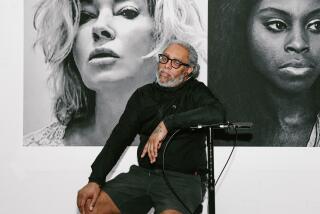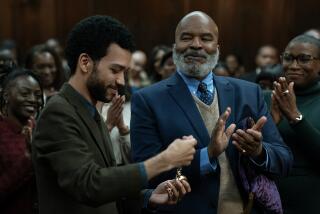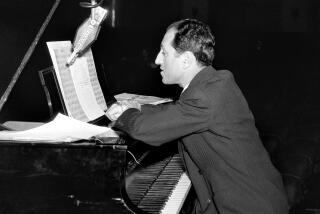Nathaniel Ayers plays the Foshay Learning Center
I picked him up at 10:30 Monday morning. He was waiting on the sidewalk outside his apartment with a cello, a violin, a guitar, a trumpet, a walking stick and a backpack full of music.
“Good morning, Mr. Ayers.”
“Good morning, Mr. Lopez.”
When Nathaniel Ayers and I go places together, I’m the driver. But he’s the talent, as they say, so in a sense, I’m just along for the ride. Such was the case as we headed off to the Foshay Learning Center, a K-12 school near Western Avenue and Exposition Boulevard, where Mr. Ayers was slated to perform.
A woman named Janise White, whom I’d never met, directs the Afro-American Chamber Music Society Orchestra. She had heard about Mr. Ayers through some colleagues and called me to say she thought it might be nice to play with him at the school concert.
I’m like a stage parent in situations like this, thrilled at the opportunity for Mr. Ayers but worried that he’ll feel too much pressure, or not find the setting or the vibe to his liking.
I explained to White that Mr. Ayers is immensely talented but somewhat mercurial, as he has been since leaving the Juilliard School 40 years ago after being diagnosed with schizophrenia. Then there’s the fact that he insists on playing instruments other than the one on which he was trained: the upright bass. His musical adventures are often uncharted, I warned.
Just bring him along, White said calmly, and they’d work it out.
The dilapidated Foshay auditorium was shut down for remodeling, so we were led to the music room for a rehearsal. White had not brought her entire orchestra along. Just violinists Phil Johnson and Shigeru Logan and cellist Kevan Torfeh. It occurred to me, as a trained professional observer, that Johnson and Torfeh did not appear to be black, so I wondered how they had landed in the Afro-American Chamber Music Society Orchestra.
White isn’t particular about the musicians, they said. Her mission, as a music teacher and historian, is to present and preserve compositions by black artists for a broad audience.
The rehearsal went smashingly well. Mr. Ayers, primarily self-taught on cello, was able to keep up nicely by sight-reading pieces he wasn’t familiar with: Sinfonia No. 2 by Chevalier de St. Georges and “Danse Negre” by Samuel Coleridge Taylor. I had recommended to White that they try “The Swan” by Camille Saint-Saens, a piece very familiar to Mr. Ayers, and the quintet nailed it.
White was smiling and I was breathing easier, slipping into reverie on yet another musical journey with Mr. Ayers.
And then I met Vince Womack, who for 17 years has run the music program at Foshay. He’s a modest man who doesn’t talk himself up — it’s all about his students. But I would learn, by day’s end, that last year Womack won a prestigious Mr. Holland’s Opus Award for passing on a love of music to students.
I would also learn that the Foshay high school band played at Disney Hall and the Hollywood Bowl in the last week alone, and that many of the students Womack inspired keep coming back to say hello and thank him long after they’ve gone on to great college music programs.
“Here’s the winner of a Bill and Melinda Gates Millennium scholarship,” he said proudly, introducing me to student Jennifer Arias, who plays tenor sax but plans to switch it out for a stethoscope at Scripps College, where she will be a pre-med student. There had been nothing about the bleak appearance of Foshay’s exterior that prepared me for the spirit and hope I found inside.
Womack also introduced me to star pupil Cesar Portillo, who plays guitar, trumpet and bass, and also sings. Cesar, whose father is a carpenter and whose mother is a babysitter, told me he has known for years that music would be his life. He once played in Carnegie Hall and plans to audition this summer for Juilliard. Getting a chance to meet Mr. Ayers, he said, was an inspiration, who has never lost his love of music or stopped trying to get better.
When Cesar moved along, I began talking to Johnson, one of the violinists, about the luxury of making music in the middle of the day. But Johnson was happy to be making music, period, letting on that he was diagnosed a couple of months ago with stage four pancreatic cancer.
He said his longtime dream has been to record the Sibelius Violin Concerto for a CD, and his buddy Torfeh, the cellist, is trying to field an orchestra in time.
“We’re all going to die,” Johnson said casually, as if he’d come to terms with the mysteries of life and death. In September 2001, he said, he was supposed to buy plane tickets for his wife and two children but had a premonition and didn’t make the purchase. The plane, headed from Boston to Los Angeles, crashed into one of the World Trade Center towers.
The narratives in this one room, on this one day, could fill a book. Lives winding down, lives altered, lives just beginning. Inner-city opera in the afternoon.
The concert, an encore and a jam session involving Mr. Ayers and several students, were a triumph, with Womack joining them on trumpet and science teacher Craig Gross wailing the blues.
Womack told his kids that when he took the baton and led them at Disney Hall, “It was one of the greatest musical experiences of my life.” And then he and the students offered up a piece called “Heaven’s Valley,” their way of saying thank you to Mr. Ayers.
More to Read
Start your day right
Sign up for Essential California for news, features and recommendations from the L.A. Times and beyond in your inbox six days a week.
You may occasionally receive promotional content from the Los Angeles Times.







